Hungary, a Country Torn and Tattered
and then stuck together again
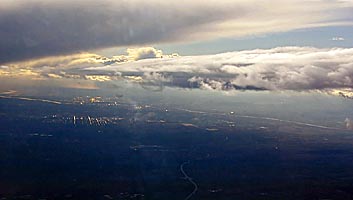
Over there, below the clouds, is Budapest in all its splendour.
The long, gleaming band is the Danube.
In the autumn of 2003, Budapest in Hungary was the
destination for a conference trip. Let's forget the conference and have a look at this architectural pearl by the
beaches of river Danube.
Going There
|
|

|

|

|
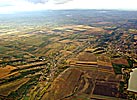
|
| The Baltic Sea has a thin, low cloud layer, but it clears up as we fly in over Gdansk in Poland. What you see is
the thin Polish sandbank Mierzeja Helska going out into the Baltic Sea. Such narrow sandbanks occur along the whole
Baltic coast, all the way up to Finland. When we reach Hungary the clouds are gone and the last picture shows mountain
slopes with vineyards. The trip ends with the large picture above, with Budapest in the evening sun along the Danube. |
Quick History
|
|

Bela III, popular king in the 12:th century
|
The Hungarians, or the Magyar as they prefer to be called, immigrated into modern day Hungary in 895, creating
their own kingdom. The first Hungarian nobleman assuming kingship was István I (1001), named Vajk before
christening. That was the end of pagan times.
The Hungarians like to talk about the great times between 1870 and 1910, when culture blossomed and all the beautiful
buildings were erected in the city. They talk fondly about the Great Exhibition in 1896 for which the whole city
seems to have been enlarged, the avenues widened, the parks planted, the first metro line drawn from the centre
to the Town Park, where, in its turn, all the festivities took place, etc.
1914 came World War I and shattered the economy. The interwar period didn't help very much, either.
The city was bombed to smithereens during Word War II, and when they had thrown the Nazis out, the Soviet Union
came and sunk the country into the darkest abyss they had ever witnessed. This twisted form of government that
gave nothing but repression and destruction left the country for good in 1989, and Budapest could rise to its former
glory. |
Raoul Wallenberg
During World War II the Jews were tormented by the Holocaust. The Nazis deported an estimated 560,000
Jews from Hungary, and our Swedish diplomat Raoul Wallenberg saved a few thousand of them. Unfortunately the Soviet
Union took him, to what was probably a horrible death in some Soviet prison or some concentration camp in Siberia.
We will never know which. Wallenberg has been honoured with a monument and a street in the city. |
“1956, Budapest is rising, 1956, Budapest is falling, 1956, Budapest is dying...”
Who doesn't remember these words from the musical Chess? And now, here I am on the streets where the riots
happened and I can see the result. Oh, destiny, to always sit on the border between Communism and Nazism, between
east and west, between dictatorship and democracy, and be bombed by both of them!
It is strange in East Europe and especially in Hungary: from Roman time the have preserved many highly esteemed
bathhouses, health spas and vineyards. The Turkish occupants from the 16:th century left a lot of high culture
and beautiful buildings behind. Austria left the music. But after Communism there is nothing at all worth saving.
No one wants to remember decay and poverty. All the old Communist sculptures have been erected in a sculpture park
outside the town, where you can walk around and be horrified about hem. There is only one left in town, and someone
had poured crude oil on it when I was there. The police was unnecessarily investigating the case.
After Perestroika in 1985 and the fall of the Soviet Union in 1991, Hungary rose anew and the old cultural values
were re-introduced. The oldest and most beautiful parts of town are being restored, the churches are being repaired,
but there is still a lot of work left. |
On the Town
Let us begin with the largest, most stunning and most shiny, that you can walk around in for hours and not get
enough of anyway: The churches and palaces.
St. Stephen's Basilica - Szent Istvan
|
The first thing that happens when you enter the gate is that your jaw drops down on your
chest. Then, your index finger drops down on the shutter, and you cant get it off until after 200 exposures. After
three hours you leave, with a lump in your throat. That's how beautiful it is.
The St. Stephen's Basilica (Istvan) was so beautiful it alone was worth the trip. In beauty it competes hands down
with St. Peter's Church in Rome (see
link). It is named after the country's first king, St. Stephen (Szent Istvan).
The church is all dark. The splendour has been brought to you through long exposures. There are a lot of pictures,
perhaps more than necessary. They are there for your pleasure! |
|
|
18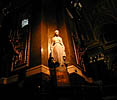
|
18
|
1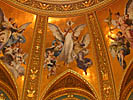
|
|
1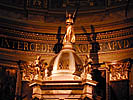
|
|
|
|
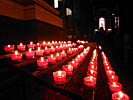
|
|
1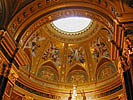
|
1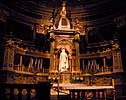
|
1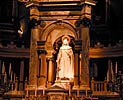
|
1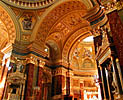
|
1
|
|
16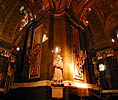
|
8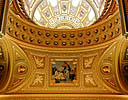
|
6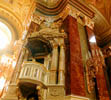
|
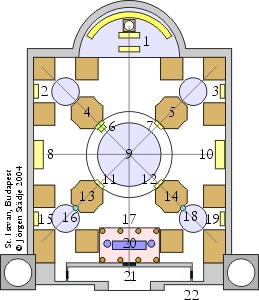
|
9
|
7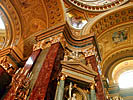
|
|
8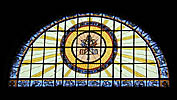
|
13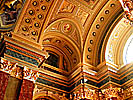
|
4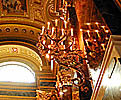
|
9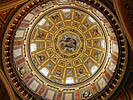
|
7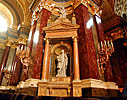
|
|
8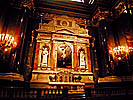
|
8
|
4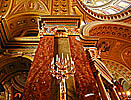
|
9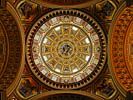
|
|
|
15
|
17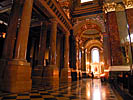
|
17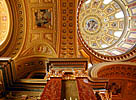
|
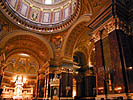
|
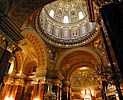
|
9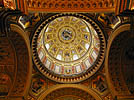
|
|
|
15
|
15
|
17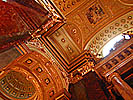
|
20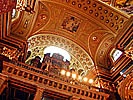
|
20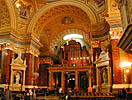
|
17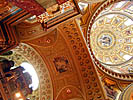
|
11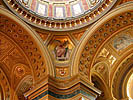
|
| |
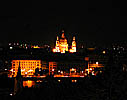
|
21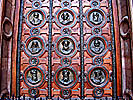
|
21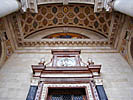
|
21
|
22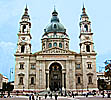
|
22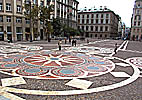
|
|
Some Comments
|
| 1. The roof above the altar is magnificent, all gold and inlaid paintings. |
The night shot was made from the Buda palace area. |
9. A zoom-in towards the dome centre. |
21. The great gate has images of the 12 apostles laid in. |
22. The church is kind of squeezed in. I have removed a few buildings. |
|
The Buda Palace Area
|
|
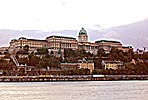
|
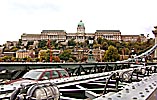
|
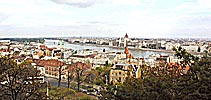
|
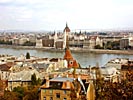
|
|
Buda looks real grand, and it becomes even grander when you get up there.
|
The famous Chain Bridge leading over the Danube straight to the funicular.
The bridge is a piece of art in itself.
|
The view is ravishing, but it could have been better if the weather had
been good.
|
Zooming in on the Parliament.
|
|

|
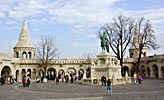
|
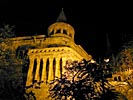
|

|
|
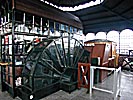
|
The St. Mathew's Cathedral was restored in 1890 and the architect thought it looked a bit naked
on the cliff edge, so he added a romantic viewpoint. The other image shows the viewpoint from below, at night.
|
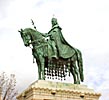
|
|
To get up to the palace area you ride the funicular. It costs 500
forints going up, but only 400 down!
|
|
The first king Szent Istvan (St. Stephen) sits on the horse. He's everywhere,
that guy.
|
St. Mathew's Cathedral
|
| Front: The altar and St. Lazlo's Chapel (9) and a Blue Planet |
Middle: Look at the fantastic ceiling and the stained glass |
Rear: The black, rather thinly populated organ and many artful details, especially the pillars. |
|
1
|
2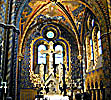
|
3
|
4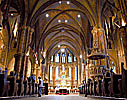
|
5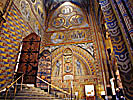
|
6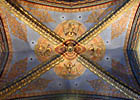
|
|
7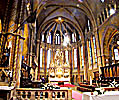
|
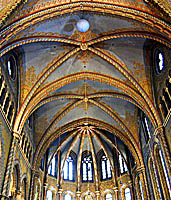
|
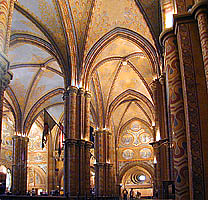
|
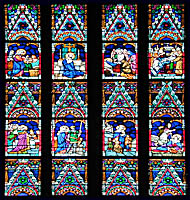
|
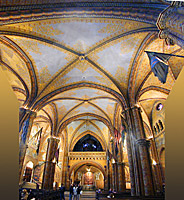
|
8
|
|
7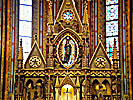
|
8
|
|
9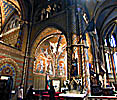
|
10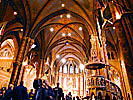
|

|

|
11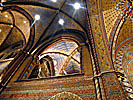
|
11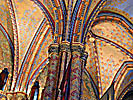
|
|
9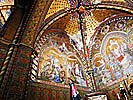
|
9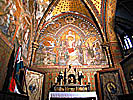
|
12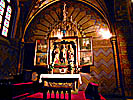
|
13
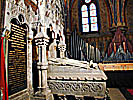
|
11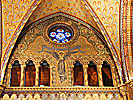
|
11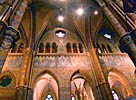
|
|
14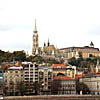
|
15
|
16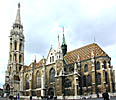
|
17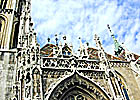
|
18
|
19
|
Some Comments
|
1-2. Forward side altar
7. Main altar
12. Side altar |
15. The tower is called Bela's Tower |
9. The exposure in St. Laszlo's chapel is optimised for the wall decorations, which were
rather “thin”. |
13. Bela's chapel with part of the organ |
14-18. Zooming in from Pest to a detail in the masonry over a side gate |
8. Rear chapel
19. Trinity statue |
The church has three naves - right, left and middle. The side nave's ceilings are yellow
and the middle one sky blue. The pillars are artfully decorated in many, clear colours. No dull grey, here. Note
the blue planet above the altar.
St. Lazlo's chapel was richly decorated but in dire need of renovation due to dampness.
The large ceiling pictures have been carefully “washed” of downlights. This church has dreadful lights shining
straight down, destroying all pictures. But the visitors need them, as the church is very dark inside. |
Hösök tere - The Heroes' Square
|
| The immense relief after Communism was celebrated on the Heroes' Square with the Thousand Year's Monument,
whose statues of well-known people from Hungarian history replaced the Communist ones. |
The square had been used for Communist parades and demonstrations, but came the end of the eighties that was definitely
over. It was reinstated in 1989.
The Soviet-appointed and much hated Prime Minister János Kádár, the one who ordered Soviet
tanks to crack down on the Hungarian uprising in 1956, laid defeated, in coma and died on the very day of the festivities. |
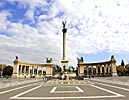
|
The 36 metre Thousand Years Column stands at the midst of the square. On top of it stands Gabriel the archangel.
He holds the Hungarian Christian double cross and the first Hungarian royal crown, representing the solidarity
between the Hungarian State and Christianity. The Vatican gave the crown after the country was officially a kingdom
in 1001. In those days it was a sign that the country actually existed, when the Vatican presented a crown. |

|
|
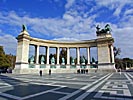  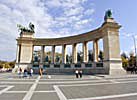
|
Gabriel the archangel with the cross and crown.
|
|
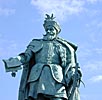
|
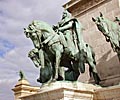 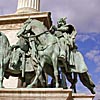 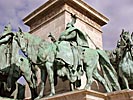
|

|
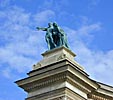 |
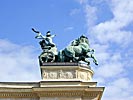 |
At the foot of the column are seven equestrian statues depicting Arpad and the other six
Magyars, seven clan chiefs from the original Hungary, who led the Magyar conquest.
|
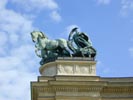
|

|
|
|
Behind the group are two bows with 14 heroes from Hungarian history. The
statues were restored in 1996. The row begins from the left with two saints and kings.
|
 |

|
1. Szent Istvan I of the Arpad dynasty (St. Stephen, 997-1038, the first king, in 1001)
2. Szent Laszlo of the Arpad dynasty (St. Vladislav, king 1077-1095)
3. Kalman Konyves of the Arpad dynasty (Kalman the Book Lover, king 1095-1116) |
4. Andras II of the Arpad dynasty (king 1205-1235)
5. Bela IV of the Arpad dynasty (king 1235-1270)
6. Robert Karoly of the Anjou dynasty (Robert the Short, king 1385-1386)
7. Lajos I Nagy of the Anjou dynasty (Lajos the Great, king 1342-1382) |
1. Janos Hunyadi?
2. Matyas I Corvyn of the Hunyadi dynasty (Mathew, king 1458-1490),
3. Istvan Bocskai?
4. Gabor of the Bethlen dynasty (king 1620-1622)
5. Imre Thököly (led the uprising against the Habsburgs, prince of Transsylvania, 1657-1705) |
6. Ferenz Ilrakosz (1703- ?)
7. Lajos Kossuth (1802-1894). He is regarded as creator of the modern Hungarian democracy and a supporter
of independence from Austria and Russia. Leader of the independence war 1848-49. |
|
The Rest of the Town
|
Bathing - a Matter of Culture
|
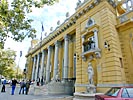 |
Swedish adventure-baths! Hah! In Hungary bathing is high culture, whereas we go bathing to allow the kids to jump
and scream their heads off. |
The decorations are equal to an opera foyer. Hungarian baths have been around since Roman times.
The Romans built baths wherever they went, especially around hot springs.
|
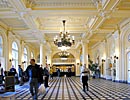
|
  |
The statues outside the Szechenyi Bath shows that you are about to enter something refined, almost sacred. |
In here it is not “Pay, take your towel and go”, instead it's “Pay, have a cigar, enjoy a noble
wine, listen to languorous music, read the papers and bathe with pleasure”.
|

|
Art in the City - the City is the Art
|
  |
That Hungary was once a cultural centre of Europe is clear beyond doubt when you see the art all around town. The
only nice things are those that made it through...
Erzebet Fountain - Erzebet (Elisabeth) was queen once |
...the dark time more or less intact, although it is sometimes in awkward places on dirty, cracked
house walls. One's heart stings a little when one imagines how grand it probably was once upon a time.
Wall-mounted ladies
|
 
|
 |
Art has somehow survived in little islets here and there. It fights for its existence in a town that fights for
its renovation in general. If you look closely there are heads, angels and centaurs everywhere. |
The Budapest Opera House has a golden foyer, but inside was an angry man saying “No pictures”
so you will have to do with the sphinx outside. Normally I don't care about photo bans but this gay was just sooo
angry.
|

|
 |
The Jewish synagogue was closed for renovation. But the window was nice from the outside, too. |
Even the Chain Bridge to the Buda palace area has nice chains.
|
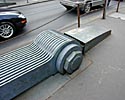
|
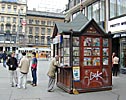 |
Hirlap - The Press |
Finally some Soviet anti-art, ugly, squared, meagre, put here for Homo Sovieticus, who was not
to question, nor have any values of beauty. Happily, it was in a hidden place.
|

|
Nice-looking Facades, without any Ranking
|
|
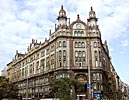
|
Fashionable street with fashionable house |

|
A red facade with interesting bricks |
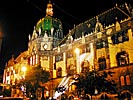
|
A museum at night-time |

|
A yellow house in the poorer part of town |

|
Banks and shops |
|
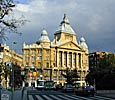
|
This is what I call a real apartment building! Although some renovation wouldn't hurt.
|
 |
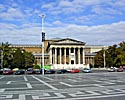
|
The Hungarian State art museum at Hösök tere |

|
A church I happened to pass |
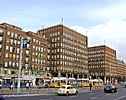
|
And finally a mistake, a soviet block of flats |
|
The Food
|
| If you do not travel to Hungary for its architecture or history, then try some food and Tokai. |
|

|
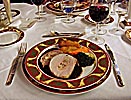
|
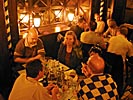
|
|
We normally term Hungarian food culture “hot”, but I have never seen burning soup before.
|
Veal with vegetables in the middle, very elegantly served, well actually the summit of serving
manners, the best I have ever seen.
|
But if you only want to have fun, the wineries and beer halls are the places to go to. This very
one had its own micro-brewery with large glass windows, so you could watch and lick your lips.
|
|
The Heritage of Communism
|
 |
Church on Klauzal utca. It had had a rough ride through Communism, and probably been used as storage or the like.
I don't know very much about it, other than that it was frightfully dirty on the outside. |
The fashionable streets are nice, but as soon as you venture into a back street, the decay is
still visible. This will cost Hungary dearly, and it will be many years before the country has risen out of Communist
darkness.
|
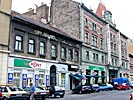
|
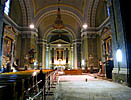 |
Repairs are under way, but almost all friezes are painted, meaning that they were smashed earlier. A new floor
was being cast. |
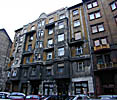
|
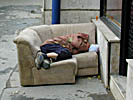 |
Down-and-out people are always a deplorable part of the cityscape, although this one was lucky with his resting-place. |

|
What weighs most heavily on my heart are all the poor, broken people tending the heritage of the Soviet Union
in the form of shot-off legs or just utter poverty. Impoverished women that, after their husbands died in Stalin's
meaningless wars, are devoid of all means of support, and will have to while away the rest of their lives as shrivelling
elders on the city's streets and squares. In the evenings they flock in the metro hallways, weighing down my heart
like lead - people who, without any fault of their own, have fallen into degradation and misery.
Hungary has undoubtedly a lot to offer its visitors. Fantastic palaces, churches so beautiful that tears almost
prevents you from taking pictures, an amazing amount of local beers, but most of all, culture, immense contrasts
and a wind whispering of the way it was before, and may once again become.




